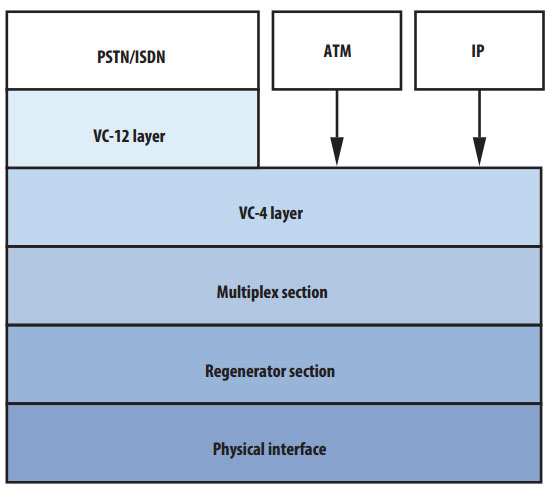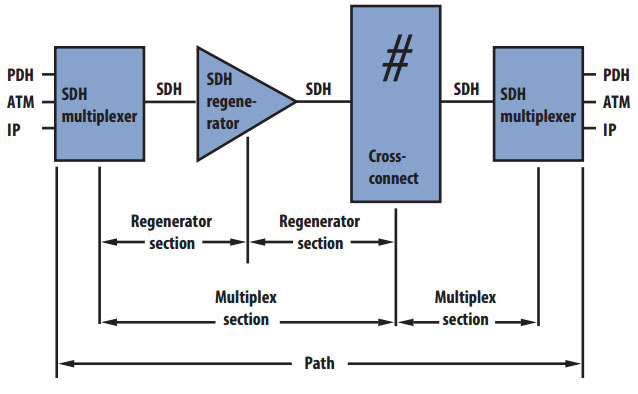Communications networks gradually converted to digital technology after PCM was introduced in the 1960s. A multiplex hierarchy known as plesiosynchronous digital hierarchy (PDH) evolved to cope with the demand for everhigher bit rates. The bit rates start with the basic multiplex rate of 2 Mbps with further stages of 8, 34, and 140 Mbps. In North America and Japan, however, the primary rate is 1.5 Mbps with additional stages of 6 and 44 Mbps, as shown in Figure 1 on page 5. This fundamental developmental difference made gateway setup between the networks both difficult and expensive.
In response to the demand for increased bandwidth, reliability, and high-quality service, SDH developed steadily during the 1980s, eliminating many inherent disadvantages in PDH. In turn, network providers began to benefit from the many technological and economic advantages this new technology introduced as discussed in this section.
High transmission rates
Transmission rates of up to 10 G can be achieved in modern SDH systems making it the most suitable technology for backbones, the superhighways in today’s telecom-munications networks.
Simplified add and drop function
Compared to the older PDH system, low-bit-rate channels can be easily extracted from and inserted into the high speed bit streams in SDH, eliminating the need for costly demultiplexing and remultiplexing the plesiosynchronous structure.
High availability and capacity matching
SDH enables network providers to react quickly and easily to their customers’ requirements, such as switching leased lines in just minutes. Network providers can use standardized network elements (NE) that they can control and monitor from a central location with a telecommunications management network (TMN) system.
Reliability
Modern SDH networks include various automatic backup-circuit and repair mechanisms that management can monitor to cope with system faults so that link or NE failures do not lead to an entire network failure.
Future-proof platform for new services
SDH is the ideal platform for a wide range of services including POTS, ISDN, mobile radio, and data communications, such as LAN and WAN. It can also handle more recent services such as video on demand and digital video broadcasting via ATM.
Interconnection
SDH simplifies gateway setup between different network providers and to SONET systems. The SDH interfaces are globally standardized, making it possible to combine NEs from different manufacturers into a single network which reduces equipment costs.
The trend in transport networks is toward ever-higher bit rates such as STM-256 (time division multiplex,TDM); however, these NEs can be cost-prohibitive. Another cheaper alternative is dense wavelength division multiplexing (DWDM) which uses multiple single-mode optical fibers to transmit digital signals through several fibers simultaneously. (See the DWDM Pocket Guide for more information.)
DWDM is closely associated with the “all-optical network.” In terms of the ISO-OSI layer model, OADM and optical cross-connect (OXC) development basically means introducing an additional DWDM layer below the SDH layer (see Figure 2). Therefore, future systems will likely combine higher multiplex rates with DWDM.
The synchronous digital hierarchy in terms of a layer model

Telecommunications technologies like SDH are generally explained using so-called layer models.
The uppermost layer represents the applications of the SDH transport network.
SDH networks are subdivided into various layers directly related to the network topology. The lowest layer is the physical layer, which represents the transmission medium, usually a glass fiber or possibly a radio or satellite link. The regenerator section is the path between regenerators, see Figure 3. Part of the regenerator section overhead (RSOH) is available for the signaling required within this layer.

The remainder of the overhead, the multiplex section overhead (MSOH) is used for multiplex section needs and covers the part of the SDH link between multiplexers. The carriers or virtual containers (VC) are available as payload at each end of this section which represent a part of the mapping process, the procedure of packing the tributary signals such as PDH and ATM into SDH transport modules. VC-4 mapping is used for 140 Mbps or ATM signals and VC-12 mapping is used for 2 Mbps signals.